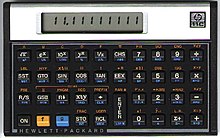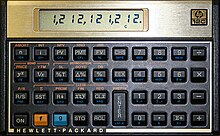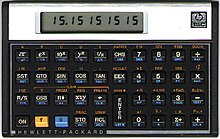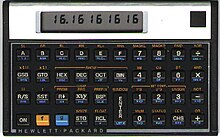HP-10C series
The pocket calculators of the HP-10C series ( "Voyager" ) were launched by Hewlett-Packard (HP) in 1981 as the successor to the 30 series . The series includes the models HP-10C, HP-11C, HP-12C, HP-15C and HP-16C, all of which have an almost identical external appearance in the characteristic landscape format; only with the HP-12C is the metallic upper part gold instead of silver. The number, size and arrangement of the buttons are also identical, they only differ in their assignment. All computers in the Voyager series are equipped with the same 10-digit LC display . For the first time, button cells (three LR 44 type) are used for power supply on HP computers. All models are programmable, but have no interfaces - neither the external saving and loading of programs nor the connection of printers or other extensions is possible. The computers use reverse Polish notation (UPN) as the input method .
Models
The HP-10C series includes five models (with the year of their production):
- HP-10C - Mathematical and Scientific Calculator; Base model (1982–1984)
- HP-11C - Mathematical and Scientific Calculator; medium requirements (1981–1989)
- HP-12C Financial Calculator (1981-present)
- HP-15C - Mathematical and Scientific Calculator; high demands (1982–1989)
- HP-16C calculator for computer programmers (1982-1989)
The HP-11C and HP-12C were introduced as the first models in the series on September 1, 1981, the HP-15C and HP-16C followed on July 1, 1982 and the HP-10C two months later on September 3, 1982. During the series largely ended in 1989, the HP-12C - with an updated interior - is still available today.
HP-10C
The HP-10C served as the basic model for simple mathematical and scientific problems and is the model with the smallest equipment in this series. The HP-11C represented the greatest internal competition to the HP-10C, as it offered roughly twice the scope of performance for a relatively small additional charge (the HP-10C cost US $ 80). Bad sales figures meant that the HP-10C only stayed on the market for a short time, and production was stopped as early as 1984. It is therefore certainly the rarest model in this series.
HP-11C
The HP-11C is a mathematical and scientific calculator for medium requirements. Compared to the HP-10C, hyperbolic functions, a pseudo-random number generator and functions for calculating probability have been added, the memory is about twice as large. 15 labels, 8 comparison operations (instead of just 2 as with the HP-10C), subroutines (4 levels), indexed addressing and two flags are available for programming. The memory comprises 30 registers of 7 bytes each, one of which is permanently assigned to index register I; the other registers allow up to 203 program steps, or up to 20 data memories with 63 program steps, which are converted automatically. The HP-11C was priced at $ 135 in 1981 and $ 56 in 1989.
HP-12C
The HP-12C is a widely used programmable financial calculator. In addition to extensive basic functions, it can be used to carry out various common calculations - including iterative ones - of financial mathematics: internal rate of return , annuities , present value and final value , as well as amortization calculations . In 2003 the HP-12C Platinum came onto the market, which has some additional functions and a revised design (platinum-colored). The 12C has been produced externally and functionally unchanged for over 35 years, which should be unique for an information technology device, especially a pocket calculator.
HP-15C
The HP-15C was considered a high-end pocket calculator, in addition to the HP-11C it offers zero point determination , numerical integration , calculating with complex numbers and extensive matrix functions . It was the successor to the successful HP-34C and significantly expanded its range of functions.
The memory area - again roughly doubled compared to the 11C - can be distributed between data and program memories and is managed dynamically. The matrix functions for up to five matrices, which were all elegantly embedded in the UPN logic, were a complete novelty. Calculations with complex numbers are possible with a second stack just like with real numbers, with exactly the same use of all four stack registers. The HP-15C was priced at $ 135 when it was released. Because of its high performance, the 15C is a very popular used device and today it achieves prices that are higher than the original value at the time. In 2011, a successor from Hewlett Packard that was identical in appearance and function, but with a new interior, was sold on the US market as a "Limited Edition".
HP-16C
The HP-16C is the first and only pocket calculator from HP specially designed for programmers (e.g. with shift and rotate functions, adjustable word length and complement representation, etc.). It enabled the representation and conversion of the various number systems with one another (DEC-BIN- HEX-OCT) as well as logical links and can be used in particular to reproduce computation steps close to the assembler.
The HP-16C was priced at $ 150 when it was released, which was later lowered to $ 120.
Texas Instruments brought the TI Programmer back in 1977 , and Casio offered the CM-100, a solar-powered computer with a similar range of functions.
technology
The "Voyager" computers were u. a. Developed with the aim of low energy consumption. In this way, the leakage currents of the CMOS circuits used have been reduced to what is technologically possible. The aim of the designers was to be able to work for three to six months with one set of batteries: In practice, the computers usually lasted several years with one set of batteries, whereby the devices do not have a mechanical interruption of the electrical circuit.
Internal structure
The register-wise organization of the memory results from the selection of a CPU with internal 56-bit wide registers, a variant of the CPU of the HP-41 . This word length resulted from the space required for ten digits in BCD representation (4 bits each), two digits for the exponent, and the two signs of the mantissa and exponent, which also occupy 4 bits each. At the machine level, individual bits, places, groups of numbers (e.g. the complete mantissa) or bytes can be addressed - for interpretation as program commands. The memory is addressed serially. In contrast to this concept, word-by-word addressing with a length of 10 bits is used for the ROM.
arithmetic
One of the lesser-known features of this series is the quality of the built-in arithmetic, which is based on BCD as in earlier models. Hewlett-Packard was able to win over William Kahan from UC Berkeley , the architect of the IEEE 754 standard for floating point arithmetic , to design the numerical algorithms. He also wrote parts of the operating instructions.
programming
The computers in the series are key-programmable, i. That is, a series of key presses is saved and can be recalled later. Conditional branches, loop control commands and several (up to 7) subroutine levels are available for program branches. However, there is no alphanumeric display, so that a key or key sequence is still represented by digits, e.g. B. 42.21.14 for "LBL D" on an HP-15C.
The individual functions differ as follows:
| function | HP-10C | HP-11C | HP-12C | HP-15C | HP-16C |
|---|---|---|---|---|---|
| LBL | No | Yes | No | Yes | Yes |
| GSB / RTN | No | Yes | No | Yes | Yes |
| x≤y, x = 0 | Yes | Yes | Yes | Yes | Yes |
| x = y, x ≠ y | No | Yes | No | Yes | Yes |
| x <0, x ≠ 0, x> y, x> 0 | No | Yes | No | Yes | Yes |
| x> 0, x≤0, x≥y, x≥0 | No | No | No | Yes | No |
| DSE, ISG | No | Yes | No | Yes | No |
| DSZ, ISZ | No | No | No | No | Yes |
| SF, CF, F? | No | Yes | No | Yes | Yes |
| I (I) | No | Yes | No | Yes | Yes |
- ↑ The function LBL n (label, n = 0 ... 9 or A ... E) marks the jump target for a GTO or GSB instruction. The LBL instruction shifts when shortening and inserting program lines with the associated program code, so that neither a subsequent renumbering of the GTO and GSB commands nor a no-operation function (NOP) is necessary.
- ↑ GSB (Go Subroutine) and RTN (Return from Subroutine) allow the creation of subroutines.
- ↑ a b c Via g TEST n. The functions "equal" and "unequal" also work on complex arguments and matrices in the HP-15C.
- ↑ a b The functions are used for loop control, whereby a number in a register is used as a control variable; D (Decrement) counts down from a start value and I (Increment) counts up from a start value. SZ (Skip if Zero) stands for counting in steps of 1 until 0 is reached and SE (Skip if Equal) allows counting to a selectable value in a selectable increment. The values are set via the fractional part in the control register and interpreted as integer values. For example, with a start value of 9876.54321, DSE works its way up from 9876 to the end value 543 with each call in steps of 21. If the decimal part is 0, then DSE / ISE behave like DSZ / ISZ.
- ↑ The index register allows more flexible register addressing , such as the use of fields (arrays).
Evaluation and further development
The "Voyager" computers are characterized, especially in comparison to their previous generation, by their high manufacturing quality and are often still in use when they are over 30 years old. Although the technology is out of date, the displays on these computers achieve better contrasts than modern matrix displays. Used devices of the series are in great demand, for example the HP-11C and the HP-15C regularly achieve used prices well above the new price of today's pocket calculators. There are also numerous emulator programs for various operating systems , including for smartphones .
However, experience, especially with the range of functions of the HP-15C and the comparison with the HP-41 , also showed that the concept of the key-programmable computer with only numerical display was exhausted. The further development therefore led in the second half of the 1980s to an object-oriented, high-level programming language (RPL) and the computers based on it, HP-28C / S, HP-48 and their successors.
Individual evidence
- ^ Rick Furr: HP Calculators by Date of Introduction . In: the Calculator Reference . January 22, 2003. Retrieved January 2, 2011.
- ↑ According to the collector's index of the Museum of HP Calculators , accessed on January 6, 2012.
- ↑ Eric Smith: HP Voyager Calculator Variants . In: HP Voyager Calculator Variants . July 28, 2009. Retrieved January 2, 2011.
literature
- Eric A. Evett, Paul J. McClellan, Joseph P. Tanzini: Scientific Pocket Calculator Extends Range of Built-in Functions , Hewlett-Packard Journal , May 1983, pp. 25–35 ( PDF; 9.6 MB ) (HP- 15C).
- Eric A. Evett: A Pocket Calculator for Computer Science Professionals , Hewlett-Packard Journal , May 1983, pp. 36-40 ( PDF; 9.6 MB ) (HP-16C).
Web links
General links
- HP-10C Series Technology and Packaging - Museum of HP Calculators
- Hewlett-Packard calculator
- Images at MyCalcDB: HP-10C , HP-11C , HP-12C , HP-12C platinum , HP-15C and HP-16C
Emulators
Individuals as well as companies offer emulators for the HP-15C and HP-12C (for Microsoft Windows , PalmPilots , PDAs and smartphones ).
- Nonpareil, an open-source HP calculator emulator supports Voyager (HP-1xC) ROMs ( Engl. )
- nonpareil for Mac OS X
- hpcalc iphone HP Calculator Emulator for the iPhone ( Engl. )
- Mxcalc from 3GR Technologies ( Engl. )




